January 19 - 25, 2014: Issue 146
Allan Collins
Known to many as ‘the Master’ when a surf boat sweep for Warriewood SLSC during the first years of this great club, Allan has travelled far further during his 80 years then many. A passion for being outdoors and among the biggest shifts in the world has paved a road from Australia to Vietnam during that country’s conflict and then to Africa and into the Middle East when that region was undergoing an extensive building program during the 1980’s.
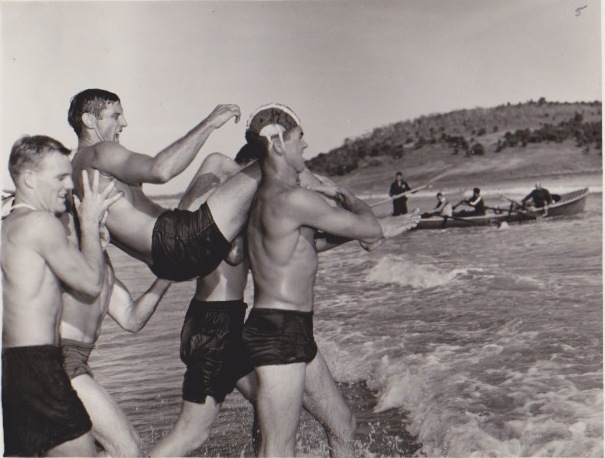 Right:
Allan Collins (sweep) - Traditional dunking for sweep after a win.
Right:
Allan Collins (sweep) - Traditional dunking for sweep after a win.
When and where you born?
In Sydney in Redfern, 29th of August , 1933.
Did you grow up around Redfern?
No, we left there when I was three weeks old to come to Turramurra. My grandparents lived up here and I’ve lived up here for a good period of my life, up until 1980 when I got married and moved out to Dural. I was at Dural for just on twenty years.
What was it like growing up around Turramurra?
It was very much a developing suburb. I came from the eastern side, down Holmes Street and Duff Street and there was nobody – it was all bush. The northern side of Turramurra was always populated, that’s where the big mansions were.
What do you remember of World War II – what incidence stands out most?
When the Japanese attacked Sydney Harbour. The trees weren’t as tall as they are now at Turramurra then, they were more sparse, and there wasn’t as much traffic noise as you have in Sydney now, so we could hear all the shipping on the harbour and the guns on that particular night. At anytime we could always hear the shipping tooting and carrying on but on that particular night it was action packed.
A bloke flew over Sydney in his aeroplane and we had a searchlight battery just opposite where we lived down in Holmes street, there were three searchlights there, they were manned by the Women’s Army who we knew through spending all our time over there; so their lights were up and all over the sky, and other lights were up too, from the Bondi area and from Parramatta too somewhere, they were up everywhere. It was a very busy night. We could hear the ships moving, we could hear the guns going. To me it was exciting because I was so young but not so to all the adults, they seemed to have a grip on how serious it was.
SEA RAIDERS SHELL SYDNEY AND NEWCASTLE HIT-RUN ATTACKS BY SUBMARINES SUSPECTED. BOOM OF COASTAL GUNS WAKES THOUSANDS - LITTLE DAMAGE DONE; ONLY ONE PERSON INJURED . Sydney and Newcastle were shelled from the sea early this morning-probably by submarines. In Sydney the bombardment began about 12.5 a.m. An air-raid alert was sounded shortly before 12.30 a.m. and the "all-clear" was sounded at 1.11 a.m. In Newcastle, the shelling began about 1.3o a.m. and lasted about 35 minutes. Two shells exploded but did no damage. At least five shells fell in Sydney suburbs and others are believed to have fallen in the harbour. As far as is known, only two exploded. A "dud" shell tore through a block of flats in Manion Avenue, Woollahra, and one man was injured. Shells fell in Rose Bay, Woollahra. Bellevue Hill and Bondi. Thousands of people in eastern suburbs were aroused from their sleep by the scream of shells passing overhead and by the boom of coastal defence gunsopening fire. The sound of the shells from the sea was heard in many suburbs, but it seemed loudest in Bondi, Bellevue Hill, Rose Bay, Bronte, Coogee, and Randwick. It was estimated that at least 12 shells were fired. SEA RAIDERS SHELL SYDNEY AND NEWCASTLE. (1942, June 8). The Sydney Morning Herald (NSW : 1842 - 1954), p. 5. Retrieved from http://nla.gov.au/nla.news-article17801108
Do you remember the day that peace was declared?
Yes I do. My parents took me into the city for the celebrations and there were millions of people. It was great.
Where did you go to school?
Hornsby Technical High to the Intermediate stage – I then went to North Sydney and did my Leaving Certificate as Hornsby didn’t go that far. Hornsby wasn’t much of a school then – the teachers were all returned servicemen, all a bit damaged and not assimilating well back into life here, they weren’t too good to be around. Not only that – we were a damned nuisance I’d say.
At North Sydney I was studying for exams – that was serious stuff. Hornsby going to the Intermediate certificate was child’s play compared to what we had to do at North Sydney – your Matriculation and Leaving Certificate – that was the one which deemed whether you went to University or not. I never wanted to do that but my parents wanted me to have a better education so I completed the Leaving Certificate.
What did you do when you left school?
A friend of our family’s, rather a wealthy crowd from Gordon owned a warehouse, Nettleton’s, in Kent Street, and I put in a year there but it wasn’t to my liking being 16 and not liking being inside. One day, just out of the blue, I picked up the phone book and looked through the various trades and picked out the closest one to Turramurra that was available, which was at Chatswood, and rang the head contractor who said to come down straight away and the next day he signed me up as an apprentice. I stayed there for 11 years and ended up being their Foreman and Project Manager – this was for the A C Electrical Company. That was owned by a returned Air Force pilot, a wonderful bloke who became a great friend of all us apprentices, Arthur Tooley.
What did you do after you left there?
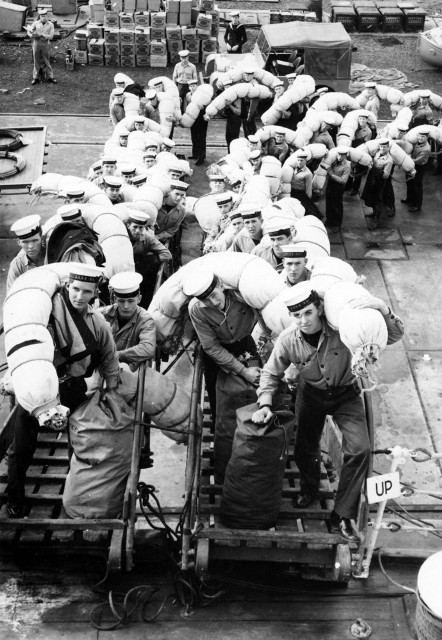 I had a yearning to be a company Rep. just so I could
travel around and wear a suit for a change. I looked around and a job came up in
a company called ‘Pyrotenax’ which were located in Grosvenor Street in the city
at this stage. After two years they moved to Leichhardt and I worked there for
six or seven years. I was selling electric cable for them – we had a territory-
I worked the Northern Beaches area and also Newcastle – I used to go up there
every six weeks. It was a good job. I had a new car given to me – always a
Holden, I’m a Holden man – this was 1956.
I had a yearning to be a company Rep. just so I could
travel around and wear a suit for a change. I looked around and a job came up in
a company called ‘Pyrotenax’ which were located in Grosvenor Street in the city
at this stage. After two years they moved to Leichhardt and I worked there for
six or seven years. I was selling electric cable for them – we had a territory-
I worked the Northern Beaches area and also Newcastle – I used to go up there
every six weeks. It was a good job. I had a new car given to me – always a
Holden, I’m a Holden man – this was 1956.
I was called up for National Service in 1954 – I did six months in the Navy through the Naval base at Balmoral beach, the HMAS Penguin – we went to sea on the cruiser HMAS Australia. I loved it – I was in the Reserves for five years after I came out of that. We NASHO’s, formed part of Queen Elizabeth’s Colour Guard during her 1954 tour here – escorting her wherever she went – there were 42 of us. Those on this duty had to be over 6 ½ feet tall and we were under strict instructions to be inconspicuous – dressed in white uniforms with chrome bayonets and epaulets mind you. The Australian Fleet escorted the SS Gothic up and down the coast for the whole of her tour here then and I recall being on duty right at her elbow.
Allan’s Date of Intake was 4/1/1954, his service number is 4141 NS.
Right: Some of the National Service recruits to the R.A.N. boarding HMAS Australia, circa 1953, Gift of The Age (Melbourne, Vic.), courtesy State Library of Victoria.
In February and March 1954 Queen Elizabeth II and her husband,
Prince Philip, Duke of Edinburgh toured Australia. This was her first visit to
Australia since her coronation and the first by a reigning monarch.
Early in 1952 she began a tour with The Duke of Edinburgh when King George VI's health prevented him carrying out further Commonwealth tours. It was at the beginning of this trip that the King died peacefully, on 6 February 1952, at Sandringham House in Norfolk. Princess Elizabeth was in Kenya on her way to New Zealand and Australia when she received this news. The coronation of Queen Elizabeth II as monarch of the United Kingdom, Canada, Australia, New Zealand, South Africa, Ceylon, and Pakistan took place on 2 June 1953.
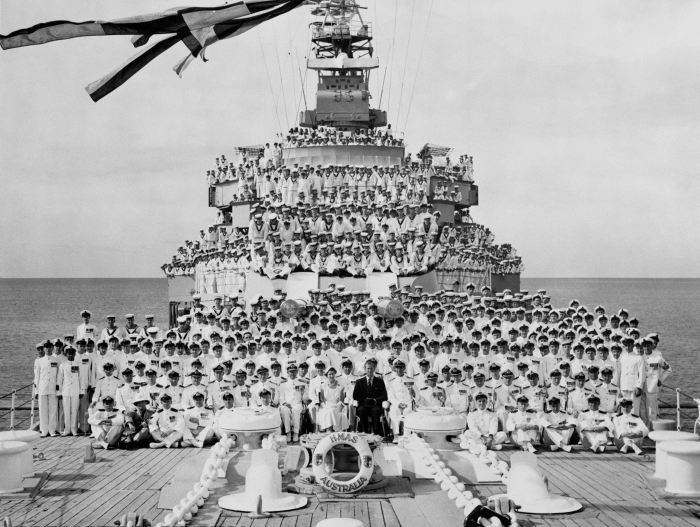
An Australian Screen (NFSA) series of clips entitled The Queen in Australia, shot by a total of 16 cameramen, documents her visits to each state capital and many regional areas. Major sequences include the arrival of the Royal Navy ship SS Gothic in Sydney Harbour, the Queen opening the 20th Australian Parliament in Canberra, attending a cricket Test in Adelaide, horse races at Royal Randwick and Flemington, tennis at Kooyong in Melbourne, and major exhibitions by schoolchildren in several cities. See here.
National Service was changed from six months to three months
during the later part of 1954:
PASSING-OUT PARADE. Flag-Officer in Charge East Australian Area, Rear Admiral H. A. Showers, talks to national service trainees at their passing-out parade at H.MA.S.Penguin, yesterday afternoon. The trainees had just completed 154 days training ashore and afloat. PASSING-OUT PARADE. (1954, December 6). The Sydney Morning Herald (NSW : 1842 - 1954), p. 4. Retrieved from http://nla.gov.au/nla.news-article18453806
Did you think about joining the Navy?
I did actually, yes. I was selected to do Officer’s Training but in those days you did as you were told by your parents, even in your twenties. My parents were dead frightened I was going to be sent up to Korea or worse. My parents, particularly my father, had no understanding of Service life and I couldn’t convince him so I stood down and didn’t take it up. To this day I wish I had, it’s my greatest regret.
What did you do after you left Pyrotenax?
When I came out of the Navy I went back to being an Electrical Trade for six months and I couldn’t stand it anymore after the life I’d been leading. I secured a job with a company called ‘Albany Felt’, an American company based up in Ourimbah – they used to manufacture textiles using the manufacture of paper and supplied paper-making felts. My job was to represent the company to pretty near all the paper mills in Southeast Asia.
I used to be one month in Australia and then one month on an aeroplane travelling through six or seven countries every second month – this was primarily Thailand, Singapore, Malaysia, Indonesia, the Philippines and Vietnam.
So you ended up over in Vietnam when that war was on anyway?
Yes, I wanted to! I was determined – it wasn’t compulsory that I go to Vietnam, but being in Thailand, I was next door to there and thought, ‘I wanted to have a look at this’ and so every second month I used to go up through Thailand and would end up in Vietnam.
Can you share anything you experienced there then?
I remember things getting blown up. In fact I was talking to one of the managers who took me to lunch up-country in Vietnam, which was pretty basic as you may be able to imagine. We were in this covered in area, like a shed, and there were about twenty Vietnamese soldiers sitting around having lunch too, and there was a hell of an explosion at what appeared to be about a mile away. I looked at this other engineer and said, ‘Are we ok?’ and he said’ yes, we’re ok, keep eating’. I looked around and the soldiers were back into their soup, so I kept eating. About five minutes later an enormous helicopter went over the top of us, one of those they used to call the ‘Jolly Green Giant’(a U.S. Air Force Sikorsky HH-3E); it was only about one hundred feet up in the air when it went over us so it nearly ripped the roof off. It was followed by three or four other helicopters – when all the soldiers took that in they quickly disappeared.
I said to the engineer ‘now?’ and he said ‘now!’. We quickly got into the car and went – at that stage there were no front lines in Vietnam – they were everywhere; so at that stage the Vietcong were behind us so we had to get through and back to Saigon. But they wree the sort of things that I enjoyed doing – I could have been shot, there would have been no fun in that.
I met some wonderful characters – semi-retired American Army people up there – the American Forces had discharged them and they stayed in Vietnam, flying aeroplanes for Air Vietnam.
One bloke in particular, who remained a lifelong image in my life, was Smokey Stober. He had this cigar permanently in his mouth, was a retired Lieutenant Colonel, who bought a job on Air Vietnam which cost him ten thousand dollars. He told me they used to make that back in six months. He was a typical Hollywood character, like those epitomised since – his co-pilot was legless when I met him, they were both were; this was at one o’clock in the morning, and they were flying up to Hue at 8 a.m. he would have had to have carried his co-pilot on board.
While we were talking Smokey found out that I used to fly small aeroplanes around like Cessnas and Beechcrafts, and said ‘what, you’ve only ever driven something with one fan? When you come back in two months we’ll do a run up to Hue and you can see the war from the north and I’ll show you how to fly one of these things.’
He was actually going to have me flying a DC-6! (laughs) he wanted to get me flying twin engines – no problem at all he thought.
Active from 1951 to 1975, Air Viet Nam (Air VN) (Vietnamese: Hãng Hàng không Việt Nam) was South Vietnam's first commercial air carrier, headquartered in District 1, Saigon. Established under Emperor Bảo Đại, the airline flew over one million passengers, including during the Vietnam War, before its collapse due to Fall of Saigon. In an unusual joint venture, Air Viet Nam was joined by Continental Air Services (CASI), a subsidiary airline of Continental Airlines set up to provide operations and airlift support in Southeast Asia,. Continental Air Services, Inc, better known as CASI, was set up to provide operations and airlift support in Southeast Asia during the Vietnam War. CASI was formed as the South-East Asia Division of Continental in April 1965 with operations starting in September 1965 using approximately 22, mainly STOL, aircraft.
In 1981 Smokey Stober visited schools in Boston speaking of his experiences and showing some of the aircraft he had flown during this conflict. He was then reported as a controller at the Federal Aviation Administration building in Nashua. See here.
When did you start flying Allan?
This was something I'd wanted to do. I went for a test flight out at Bankstown but didn’t take it up as everything was so regimented. I learnt to fly in the Philippines – that was a huge territory for me. Some of the areas I used to fly to via the Philippines airlines commercial flights and at other times I used to hire a Cessna 172 or something similar, and a pilot, and he used to be the navigator. I took all my lessons from the sitting airplane pilot and we’d fly, for instance, from Manilla over to Batuan, there was an intersting mill over there – then I’d fly down to Sabu and from there to Illigan and Cagayan de Oro and further down to another place. My job during these visits was to ensure they were using our product on their machines.
How long did you do that for?
Just on six years. I was then head-hunted by a company called ‘Tutt Bryant’ in 1982-83– they were at one time the largest earth-moving equipment manufacturer in the southern hemisphere. Whereas I was a Pacific representative and Manger with the paper industry – with Tutt Bryant I was the International Distribution Manager. I was number four on the company structure at that stage – my boss was the Managing Director and Marketing Director.
While I was still working in southeast Asia, I never went to Korea or Japan, I was always below that level – but with Tutt Bryant I inherited New Zealand – and used to manage the company’s operations in New Zealand whilst working in Sydney – so I was travelling backwards and forwards roughly every six weeks, and South Africa and East Africa.
I loved Kenya, was forever trekking around there, that was absolutely wonderful.
It was a logical move to go straight up from Nairobi through Ethiopia to the Middle East. I used to stop off at Addis Ababa which used to be the seat of the Queen of Sheba – it was a horrible place to be in then – the first time there I was in transit for four days and that almost drove me mad – I’d go out into the Game Reserves until we could go. It was a difficult place to be stuck in.
The target from there though was to get to Jeddah in Saudi Arabia – I worked Saudi Arabia, Riyadh, and Bahrain for five years. While I was there I did the rest. Based in Bahrain I would visit Kuwait, Qatar, Muscat, and Yemen. In Yemen a civil war had begun soon afterwards and I thought I’d had enough close shaves so when this occurred I didn’t go there.
I was totally taken up with working from Bahrain and loved every minute of it.
What was the culture like then – was there a curfew?
No. The population were used to Westerners coming through but women were on the banned list, you couldn’t bring any women through. The business owners had a firm understanding of westernized business practices and they were very kind, very astute businessmen. The same applied in Saudi Arabia – very kind, very astute. I met some very fine people during my years there.
I linked up with a company in Bahrain called ‘Yusuf Bin Ahmed Kanoo’. There was another company there called ‘Jalal Jalal’ which was the name of the patriarch who founded this business. Both Jalal Jalal and Yusuf Bin Ahmed Kanoo were chief advisers to the Sheik or Emir of Bahrain.
I teamed up with one of the members of the mainly English staff of Jalal Jalal, a man specialising in the air-conditioning area. These two, Jalal and Kanoo, were right hand men of HH Sheikh Isa ibn Salman Al Khalifa and were invaluable – they took me into their arms, we were in a position to meet what new plans were being made for Bahrain. The Sheik was a lovely fellow too, quite small, the kids loved him, all the British ex-pats kids loved him.
Sheik -Emir Isa bin Salman Al Khalifa oversaw Bahrain gain its independence from the United Kingdom in 1971. During his term (until 1999) extensive building and restructural works took place. It was during his term that the economic transformation of Bahrain into a modern nation and a key financial center in the Persian Gulf took place.
How long were you there?
I stayed in the Middle East at one stage for four months getting a feel of the place. Africa I’d go to for six weeks at a time. In the Middle East you have to put in an awful lot of effort to get yourself accepted because people there weren’t used to dealing with Westerners despite learning very fast during that period.
At that time they were just starting to pull all the old Middle East down. Jeddha was a pile of rocks, so was Riyadh, and Darain as was Bahrain. They were all being rebuilt. There was nothing in Dubai whatsoever. The first hotel there was the Intercontinental – all the others were just like pensionnes – they disappeared, the owners of the land selling for millions, and it became the city that it is now.
What were you doing when you returned from the Middle East?
My partner from there, John Thomas, had had a falling out with the Jalal family, which included the young bloke who was our partner. John had wanted to leave the Middle East and move to Australia, moving part of the Jalal and Kanoo organisations to here. They bought two buildings at the junction where the Pacific highway joins the Harbour Bridge – number 1 and number 4 or 5. Kanoo stayed here for years but Jalal’s business in the Middle East required more attention so they withdrew, asking John to come back. John by then was a multi-millionaire and wished to remain here. John became entangled in legal problems around this time and we decided we’d disband the partnership.
I bought a Travel Agency in at Carlingford Court which I ran for seven years with someone I'd known for 40 years. I then found out that my partner had drained over 100 thousand dollars from the business. Now the rules in Travel Agencies at that time meant we then had to put up a bond of two or three hundred thousand when this occurs, so I sold the business and retired.
Let’s talk about surf boats now Allan – when did you first go down to the Northern Beaches?
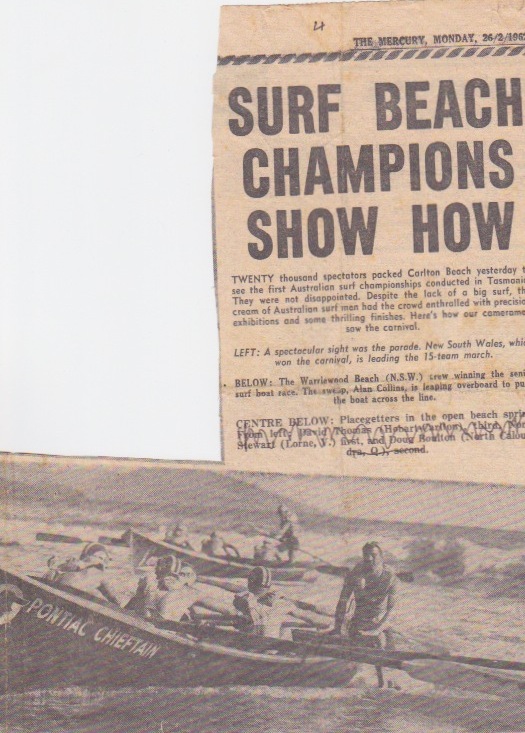 When I was fifteen. I’d go to Dee Why. There was a bus that travelled
from Pymble directly to Dee Why. I joined the Dee Why SLSC in 1949 with a bloke
from Turramurra – Brian Lovegrove.
When I was fifteen. I’d go to Dee Why. There was a bus that travelled
from Pymble directly to Dee Why. I joined the Dee Why SLSC in 1949 with a bloke
from Turramurra – Brian Lovegrove.
As soon as we got our Bronze Medallions we went in the carnivals. I went in the surf boats as juniors with Brian and I liked it – we had mixed success. I like the competition. We had some awful smashes, our sweep was not too bright. We were often in situations where we wondered if we should dive over and swim back.
Right: Winning Senior Boat Championship National Inter-State Title
I did that for seven years and I was firmly ensconced in that club. At that stage I’d started my electrical apprenticeship and a couple of the apprentices joined a brand new club, which was Warriewood. This was 1954. They knew I’d been sweeping in surf boats in competitions and they said ‘come on out’. So I did and during the course of our afternoon, there was a beautiful surf running that day, they said ‘Al, sign this will you.’ and kept talking to me while I did, and then… ‘congratulations, you’re now a member of Warriewood.’
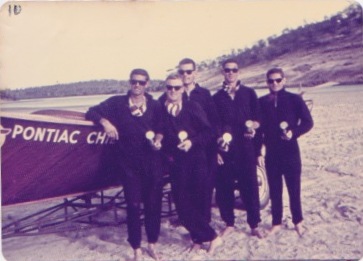
Above: Warriewood winning Seniors, National Interstate Championships - Tasmania - A. Collins (sweep) Dennis O'Brian(Bow), Harry Vannus (2nd stroke) Bob Frobes (stroke) Ross Neal (2nd stroke).
I took over the initial training for surf boats at Warriewood. There were two Dee Why juniors that were rowing with me; they decided to come out and join Warriewood; Allan Hinson and John McNamara. Johnny became in charge of the Water Police. We at that stage only had four juniors in the surf club and only 46 members altogether. Not they have 700, fabulous club! But of those 46, we took the four juniors and me and formed a boat crew and we won the State and Australian Interstate Championships – that was 1956.
What are your best memories of then?
Being out on the water racing in the surf boats – cracking waves, that was my speciality.
Where did the nickname ‘The Master’ stem from?
I’m not sure – perhaps because we were out in every sea, cracking waves. If the carnivals were called off because it was too rough, we still went out anyway. Perhaps it was because there was no one that I couldn’t beat for many years. I then earned a name for going out in prohibitive seas cracking prohibitive waves.
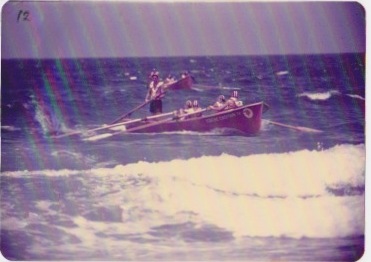 Right: Warriewood Juniors - winning NSW Champions - Bob
Forbes (stroke), Graham Gilham (2nd stroke) Jim Young (2nd bow)
Right: Warriewood Juniors - winning NSW Champions - Bob
Forbes (stroke), Graham Gilham (2nd stroke) Jim Young (2nd bow)
I can recall three waves which may have added to this; a carnival was cancelled at North Palm Beach and we rowed in company with a Bilgola crew out through the surf and down to Palm Beach – kiddies corner. We were both catching a wave in, which apparently was around 35 feet high. Just as we broke through the top of the wave and went down the front the rain stopped and the sun came out and shone on us. That was one wave that I can still remember because the bottom of the surf boat was wobbling and we were wondering if it was going to split open with the speed we were travelling at.
The second wave was in the State Championship up at Crescent Head - this was an enormous sea, we ran second in that title. The wave we cracked there was from at least 800 yards out – we’d gone past the boat buoys by at least a hundred yards before we turned, and we picked up a wave from there to the beach. That wave broke at around the 30 foot mark.
We used to quite often go to the bombora at Long Reef and crack those waves there – they were and are startling.
We would train, at night, at Little Manly when the ferries used to stop because the seas were so big. We would row out into the middle of the Heads and crack the waves – bloody stupid! We’d crack these waves, in the dark, avoiding shipping – we got out the way of a submarine once and I recall rowing aside to let a destroyer go past – no one on either of those ships knew we were there – they couldn’t see us!
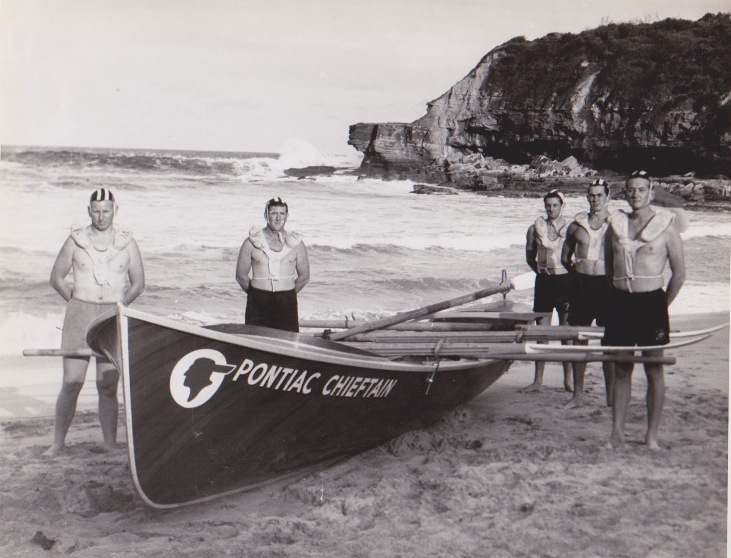
Warriewood Seniors after winning Branch, Metropolitan and 2nd NSW Titles - Brian Evans (bow) Ken Asang (2nd bow) Stan Magee (2nd Bow) Bob Forbes (stroke) Allan Collins (sweep).
So I think that may be where part of that name came from; it was the volume of the water we used to play in and crack. The other clubs never did it. It was a wonderful thing to be part of a crew and train them up to a National standard and win National titles. When I was in Dee Why we won the same amount of medals that we later did for Warriewood.
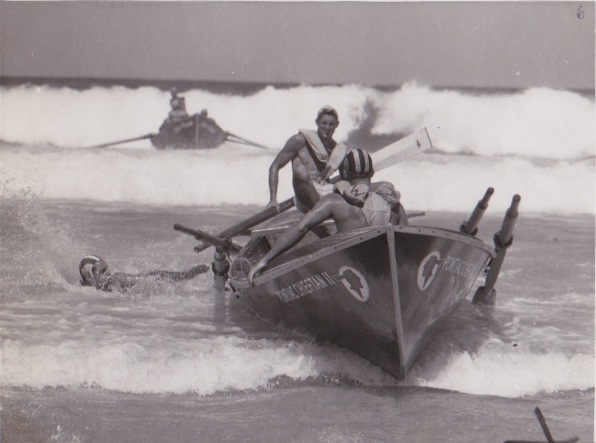
Above: Warriewood wins Metropolitan Championship - Maroubra: remaining in boat- Barry Doolan (bow), John Taylor (stroke) - in water; Allan Collins (sweep). Below: Warriewood seniors at start and winning Metropolitan Championships at Newport Beach - John Taylor (stroke), Stan McGee(2nd stroke), Barry Doolan (bow), Allan Collins (sweep).
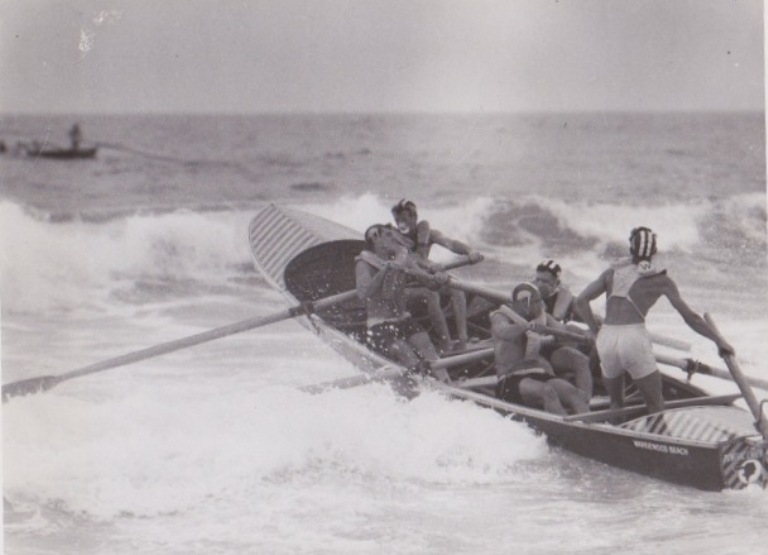
How did it feel to have a surf boat, the Allan Collins, named after you?
When I first realised what was happening I was speechless. I was so pleased and proud.
In the old days we were always able to get hold of a new boat, we went looking for sponsors. The Packham Company were our first sponsors – gave us the first Pontiac chieftain, they were the Holden Distributors. They actually floated us the second one, which we were meant to pay off and didn’t, and they just wrote it off. Then we raised some money ourselves – don’t ask me how, but we always had enough money to buy a new boat each year. If you didn’t have the new timber boat, the other ones were outdated and too heavy and slow – so we were fortunate to have the latest and greatest and we were up there with the best of them.
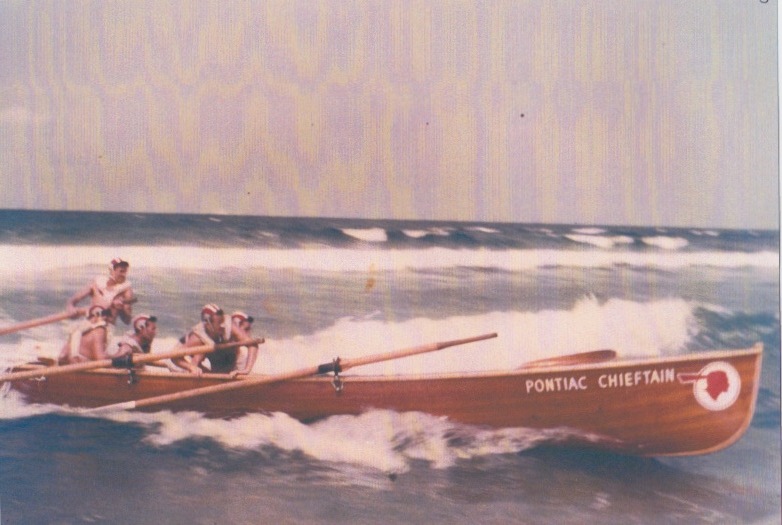
Warriewood surf boat crew winning final of first open boat race.
What’s the main difference to you between the old style wooden surf boats and the fibreglass ones raced now?
The fibreglass ones are more buoyant – they’re a bit wider. I think they’re harder to handle when you first get hold of them. It would take me, although I’m 80 years old now so I won’t be doing it, but under earlier conditions it would take me up to two months to handle one as well as I could handle the timber boats.
When we had just the 46 members, if we broke an oar, we used to have to buy our own. If we punched a hole in the boat, we used to have to throw in, take it to Billy Barnett and get him to repair it for us as the surf club didn’t have any money.
Who is Bill Barnett?
Bill was the manufacturer of the first flying surf boat. He was a former World Champion 18 footer, sailor and skipper. He developed this diagonal ply manufacture for 16 and 18 foot skiffs. One of the boys in the Surf Association said – they're going to be lighter and faster, and they approached Bill to build one for them and made an agreement that he wouldn’t build one for anyone else until next year, which he did, and the club which bought this first boat won the Australian titles. That proved that this was THE Boat, so from then on the plank boats just went out the door.
Very smartly another boat builder of skiffs came on too – Phillips Brothers. We figured out after the first couple of boats that the Phillip’s boats would run just a little bit faster- so virtually every boat we had from number 2 through to number 6 were all Phillip’s boats.
Tommy Phillips – Balmain boat builder; Sailing. LUCKY BOATS. (1942, April 7). The Sydney Morning Herald (NSW : 1842 - 1954), p. 8. Retrieved from http://nla.gov.au/nla.news-article17799410
What was Warriewood beach like in 1954-56?
It was all scrub – I wish I’d bought the lot! We didn’t have a clubhouse – what they used just before I joined was an Austin car packing case. During the second year I was in the club we laid out and designed a clubhouse and a fellow down there by the name of Jack MacKay, a long time stalwart of Warriewood, he did all the work on the raising of the clubhouse money and then getting it built – under his foremanship we all built the clubhouse.
 What is your favourite place in Pittwater?
What is your favourite place in Pittwater?
When I had a yacht, the Una, I used to park it over in Lovett’s Bay and also Elvina Bay, near Ken Beashel – he’s still there I think, at the Elvina Boatshed – he’d do some work on the boat and it was very pleasant to be there.
Right: The Yacht Una - steering Allan Collins, crew Norm Topp.
The Una was the Pittwater champion for several years, I bought her off a chap with the surname Taylor – she was very fast, a good boat to learn on, 38 foot long – some of those who sailed on her with me became virtually full time yacht crews elsewhere. I sold here and went up to Cairns and bought a fibreglass 34 footer called the ‘UFO’ because it had about 6’4 headroom inside it. I used to park that one at Mitchell’s Boatshed at right where the Pasadena is. All of those are beautiful spots – in fact I believe Pittwater is one of the most beautiful places in the world.
What is your ‘motto for life’ or a favourite phrase you try to live by?
The first one I would say, which is to do with sport and what I used to drum into all the brand new rowers; ‘Champions are only there to be beaten’.
The other one, which again is sporting related but can apply to business or life; ‘if you’re going to devote so much time into perfecting a practise or a subject, do it right.’
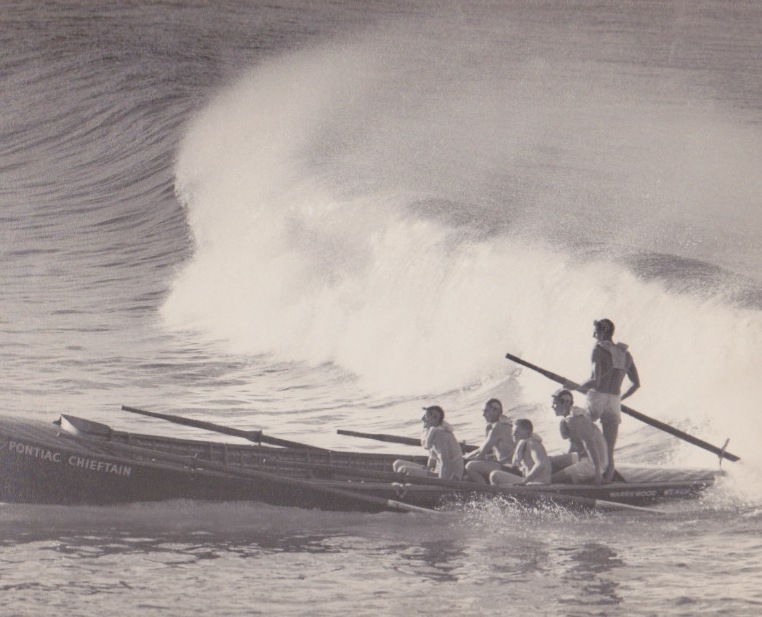
Warriewood Australian Champions, Bondi: also Branch Metropolitan, Inter-state, NSW Champions - Jeff White (bow), Merv Godden (2nd bow), John McNamara (2nd stroke) Allan Collins (sweep) Allan Hinson (stroke). Below: Same crew as above.
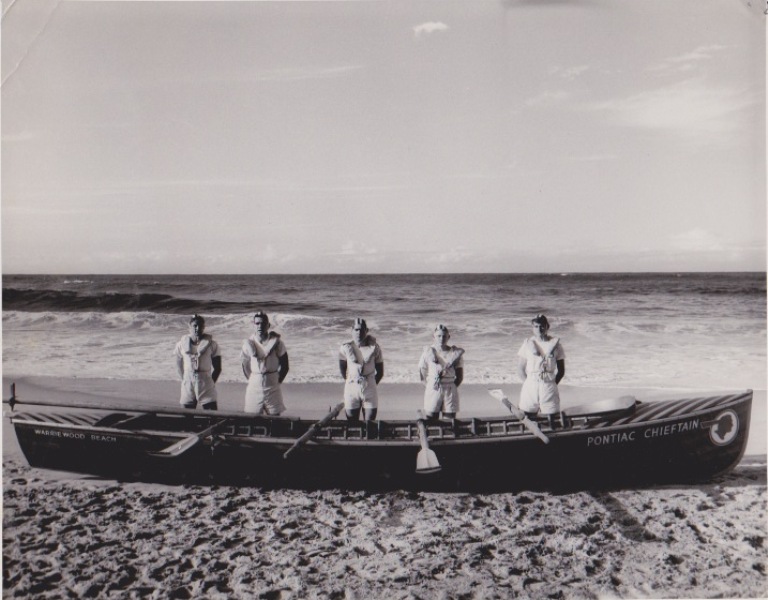
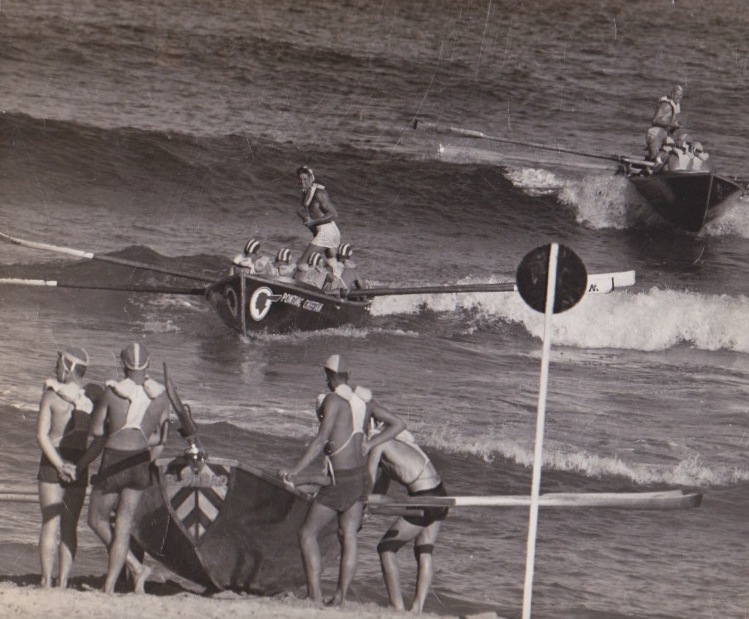
Above crew winning championship semi -final, Bondi.
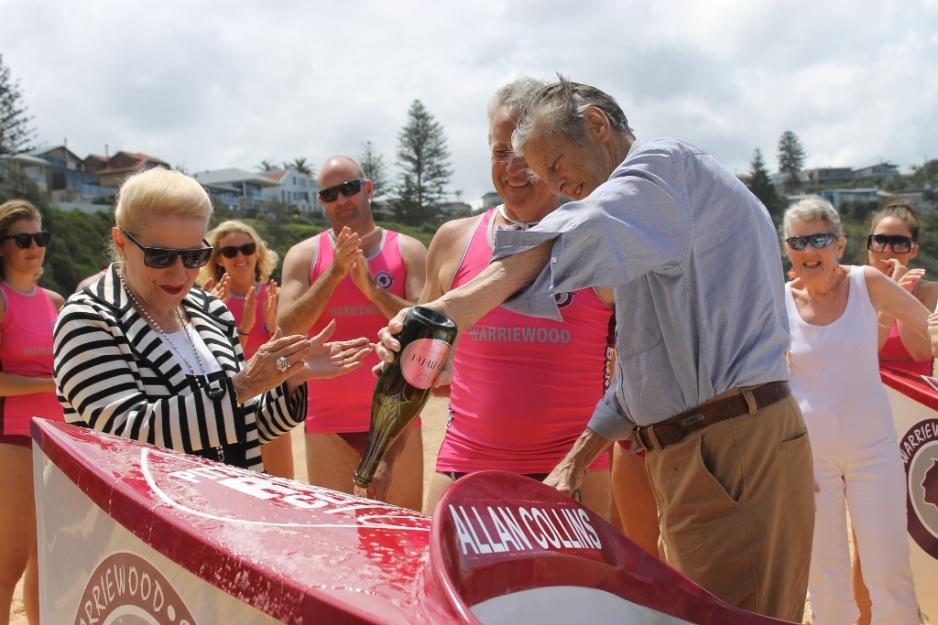
Pyrotenax
The first patent for MI cable was issued to the Swiss inventor Arnold Francois Borel in 1896. Initially the insulating mineral was described in the patent application as pulverised glass, silicious stones, or asbestos, in powdered form. Much development ensued by the French company Société Alsacienne de Construction Mécanique. Commercial production began in 1932 and much mineral-insulated cable was used on ships such as the Normandie and oil tankers, and in such critical applications as the Louvre museum. In 1937 a British company Pyrotenax, having purchased patent rights to the product from the French company, began production. During the Second World War much of the company's product was used in military equipment. About 1947 the British Cable Maker's Association investigated the option of manufacturing a mineral-insulated cable that would compete with the Pyrotenax product. The manufacturers of the products "Bicalmin" and "Glomin" eventually merged with the Pyrotenax company. The Pyrotenax company introduced an aluminum sheathed version of its product in 1964. MI cable is now manufactured in several countries. Pyrotenax is now a brand name under Pentair Thermal Management. Mineral-insulated copper-clad cable. (2014, January 17). In Wikipedia, The Free Encyclopedia. Retrieved from http://en.wikipedia.org/w/index.php?title=Mineral-insulated_copper-clad_cable&oldid=591060772
Albany Felt, Albany, New York
The Albany Felt Company was founded in Albany, NY by three business investors, James W. Cox, Parker Corning, and Selden Marvin, in 1895 to supply paper-making felts to the paper industry. Since that time, Albany has grown and is today Albany International, the world's largest supplier of felts to the paper industry. All the Company's operations were conducted in the Broadway plant from 1902 until 1947. Within the next twenty years, the Company established felt mills in Canada and the Southeastern United States, expanded into overseas markets with joint ventures that brought it into Scandinavia, Latin America, The Netherlands, France, and Australia, and made major expansions into industrial fabrics and plastics. See; http://www.albint.com/en-us/company/Pages/history.aspx
Tutt Bryant Group Limited
2013 marked the 75th Anniversary of the Tutt Bryant Group. The Group traces its origins back to 1938, when Mr Leo Edward Tutt established L. Tutt & Co. Pty Ltd selling earthmoving equipment out of a small office located in Sydney’s CBD. Armed with an idea and £500, Mr Leo Tutt would join up with Mr George Edward Bryant and embark on a journey that eventually brought about one of Australia’s largest and most iconic construction equipment sales, manufacturing and distribution companies at the time - Tutt Bryant Limited.
Over its 75 years in Australia, Tutt Bryant has continually set the benchmark for excellence in its products and services. The name Tutt Bryant invokes strong values and positive qualities that are enduring through generations in the Australian construction industry. Today, as a leading equipment sales and industrial hire service provider, Tutt Bryant continues the rich tradition of providing customers with quality, well-built and well-maintained equipment, backed by a service-oriented network of workshops, expert technicians and support infrastructure. Tutt Bryant. We’ve helped build Australia in the last 75 years, and will continue to do so for the next 75 years and beyond.
See more at: http://www.tuttbryant.com.au/
Copyright Allan Collins, 2014.